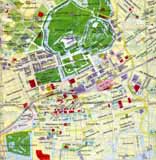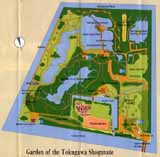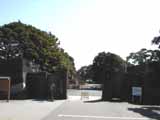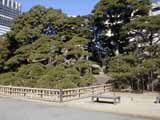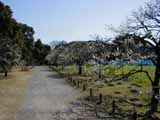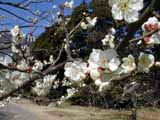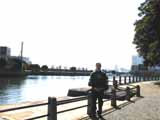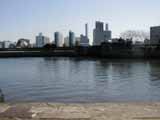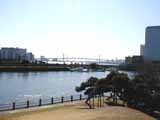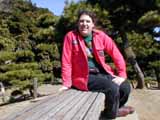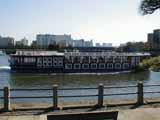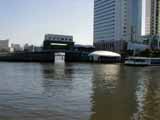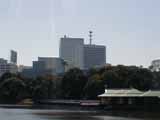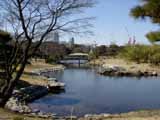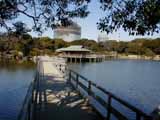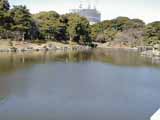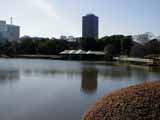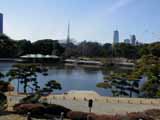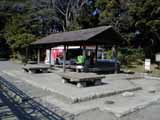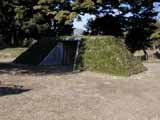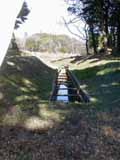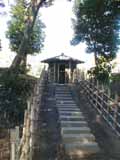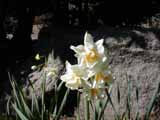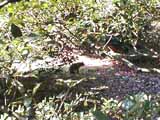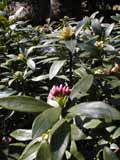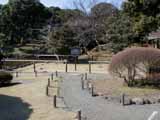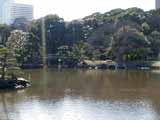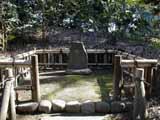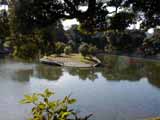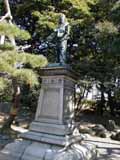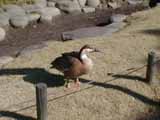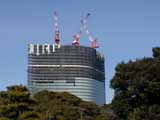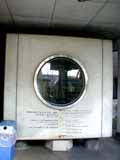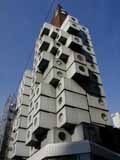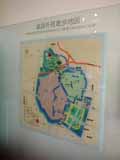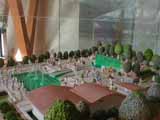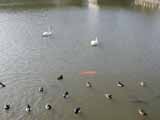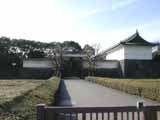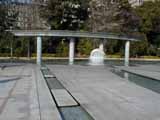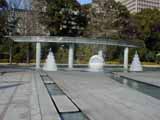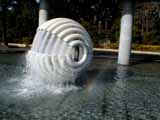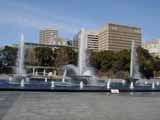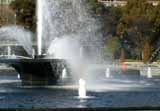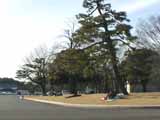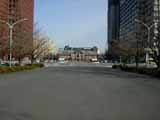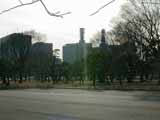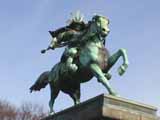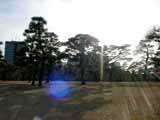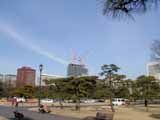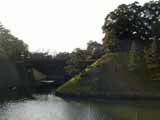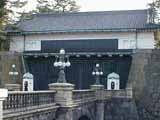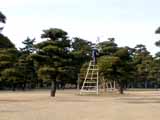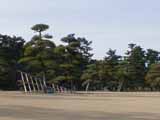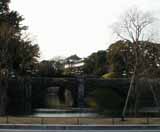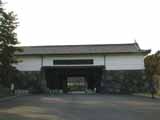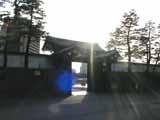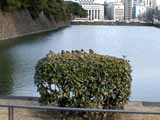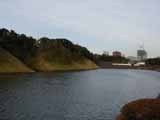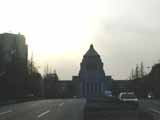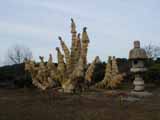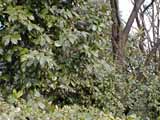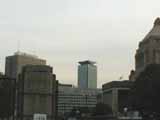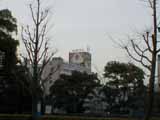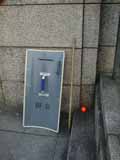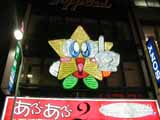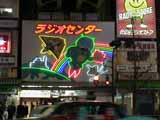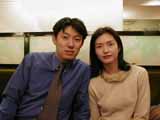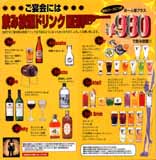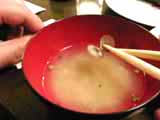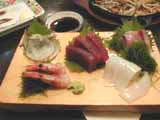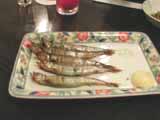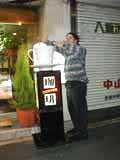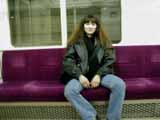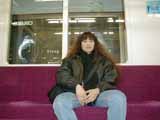Ting had to go into the office again today. I started off the day
with my errand to find a Sony Service Center so that the broken hold switch
on my DAT deck could be repaired. Armed with a neighborhood map and knowledge
that Higashi-Ginza was the closest subway station, I set off at around
9:30 AM, just in time to catch the end of the morning rush on the subway.
Good thing I'm big enough that I could bully my way into breathing space
once the doors shut!
After a bit of confusion about which exit to take from the subway
station (Higashi-Ginza is another one of those 20 exit stations...), I
made it outside, oriented myself, and set off for the Sony Service Center.
After a few minutes walk, I found the right street (it helped that the
Nissan building was near my destination), and then the right building,
with a small 'Sony' sign hanging out over the street. At this point in
the day, I was so focused on my task -- dropping off the DAT -- that I
completely forgot to take any pictures...oh well!
Once inside the repair center, I did my best to explain my predicament
in broken Japanese to the girl at the counter. It was a little frustrating,
since no one there spoke English, but by the time I left, fifteen minutes
later, I understood that they were going to try and get the deck fixed
by Saturday (instead of the normal two-week turnaround), and that the charge
would only be 2/3 the normal flat rate. Good thing I had lots of practice
haggling from past trips! I gave them the phone and address of the Akasaka
Prince Hotel for reference, then left and walked about a half mile to the
Hama-rikyu koen, or Imperial Detached Gardens.
Originally an official hunting ground for the Tokugawa Shogunate
(17th Century), the marshy fields here were reclaimed and re-engineered
for construction of a second residence to the Shogun in 1704. During the
Meiji Era, the Emperor received President Ulysses Grant during his visit
to Japan in this garden.
The pine in (1B) was planted by the 6th Shogun, Ienobu, when the
garden was extensively renovated. It is one of the largest black pines
standing in Tokyo today. The flower gardens were dead at this time of year,
but the blooms on the plum trees were bursting forth in explosions
of pink and white.
At the Shogun's dock (1D) which was destroyed by Typhoon Kitty in
1949 after surviving the bombings of WWII, a friendly old man who had just
disembarked from the Water Taxi offered to take my picture, so I took off
my gear and smiled! Unfortunately, I forgot all about the fact that I was
backlit by the morning sun, so the picture is a little dark. Note the Rainbow
Bridge in the background. You can see a clearer shot of the Rainbow Bridge
(1E), taken from my lunch spot atop Shinhinokuchi-yama, a pint-sized mountain.
And in an interesting mis-translation, the historical marker at the dock
refers to the shoguns as tycoons (rather than dictators or
warlords).
Every ten minutes or so, a Water Taxi (1G) would pass by, each one
differently shaped and colored, and each one full of people traveling between
Asakusa (where Ting and I visited yesterday) and Odaiba Seaside Park to
the East. Upon reaching the giant water gate (1H) they would slow down
and carefully maneuver inside, then the lock would close with a dull clang.
A few minutes later, the turbines to the right would stop whining, the
gate would reopen, and the taxi would be gone!
I took the next picture (1I) because there seemed to be an exceptionally
clear and bright reflection of the antenna tower on the glass walled building
immediately behind the tower. Unfortunately, the camera didn't seem to
grab the image as well as my eye did...in the photo, the reflection is
pretty indistinct.
The Otsutai bashi (cedar bridge) and the Nakajima no Ochaya (Tea-house),
depicted in the next few pictures, were originally constructed in 1707,
but bridge was rebuilt in 1997, and the current tea-house structure dates
to only 1983. It sits in the middle of Shioiri no Ike, a sea water pond
connected to Tokyo Bay by a small water gate situated near Shinhinokuchi-yama.
The rulers must have been very big on having tea, for in addition
to the Nakajima tea-house, still standing, the park contains foundations
of several other tea-houses, all within a stone's throw of one another.
One such site (1O) has been put back into use-- as a modern snack bar,
with sake, tea, beer and all the usual fare. Another, the Tsubame Tea-house
(1S) must have looked directly on at the Nakajima Tea-house, though another
attraction at that spot would be the wisteria vines trained onto a large
trellis.
Several duck hunting blinds have been maintained in good condition,
though hunting has been officially banned here since 1944. The opening
to the first blind I visited (1P) was about two meters tall and almost
as wide. Inside was a small 'room', big enough for two or three people
at most. The wall opposite the opening had two or three slit windows, maybe
15 cm long and 5 cm tall, facing an artificial water channel about a meter
wide. Although the next blind (1Q) was constructed entirely of wood, instead
of being dug out of an earthen berm, the inside was pretty much identical
to the first.
According to an explanatory sign posted nearby, the Shoguns (and
later, the Emperor) maintained flocks of captive, clipped wing ducks here
year round. Migrating fowl would see the captive flocks and assume that
the ponds were nice places to land and rest. When it was time for a hunt,
hunters would wait with bows and arrows in the blinds, while attendants
would draw the captive ducks into the appropriate channel by clapping a
slit drum, which the captive ducks had been conditioned to as a sign that
food had been set out at the end of the channel. When the captive ducks
swam up the channels, the wild ducks would follow, and the hunters would
shoot once the wild ducks were in range and the shot was clear. A pretty
complicated system if you ask me, but it must have worked well, since the
park contains not one, but two such hunting ponds, each with over a dozen
blinds.
Walking over to the Shin-senze pond, I was charmed by the appearance
of a small monument (1U) to the many thousands of ducks killed here. Apparently,
one of the Shoguns felt guilty enough to commission a memorial stone in
their honor.
On my way out, I passed by the statue of Umasimadenomikoto, (1V).
Like many of the signs I encountered throughout my visit, this one had
been written by someone with only a tenuous grasp of English. As near as
I could tell from the description, Umasimadenomikoto was a mythical warrior
from Japan's prehistorical period; his statue was commissioned as a gift
for the Meiji Emperor on the 50th Anniversary of his reign by the Army
Ministry.
And with a quizzical quack from the big brown goose at the entrance
gate, I was finished with the Imperial Detached Gardens and off to see
more of Tokyo's sights! Next stop: the Imperial Palace East Garden and
the Kokyogaien National Garden. On my way back to the subway, I stopped
to check out a capsule office building. Concrete boxes about the half the
size of a typical shipping container or train boxcar were available for
lease. Once rented, a huge crane would lift your capsule into place somewhere
along the central service tower. Weird!
Sadly, when I arrived at the Otemon (3C) after a brief subway trip
to Otemachi station and a short walk, I found the gate shut fast, as the
East garden is closed on Mondays. Curses!
I began walking back in the general direction of the Akasaka Prince,
and stopped first at the Fountain Plaza in the Kokyogaien National Garden.
About a dozen fountain installations, some large, others small, and all
interconnected via 'streams' and 'rivers' were spread across a paved plaza
about 200 m on a side. At the east side of the plaza was a large tea-house
with an outdoor deck where a few people sat drinking tea and enjoying the
constantly changing play of water in the fountains. The anteroom to the
tea-house contained the map and diorama shown in (3) and (3A).
North of the tea-house was a small zen garden of carefully raked
gravel; I arrived simultaneously with a group of about 20 upper elementary
school boys, so the garden wasn't particularly peaceful at that point in
time! The boys had entered from a passage on the far side, and walking
over, I found a path across the moat leading back into the heart of Tokyo.
I stopped to shoot a picture of the ducks (3B) then returned to the fountain
plaza to try and capture photos of some of the fountains at work.
After stopping in the middle of the street to take a picture of the
Tokyo Station Hotel in the distance, I began walking towards the South
end of the Kokyogaien National Garden. One small section of pine forest
seemed to be a gathering point for the homeless; many were grouped together,
hanging out and killing time while other slept in the waning afternoon
sunlight, or played with their dogs. One guy was riding a beat up old bicycle
in large circles, while exhorting his three dogs to chase him 'round and
'round. I continued on to the end of the park, where a magnificent statue
of the famous 14th Century Samurai General Kusonoki Masashige mounted on
a war horse stood at the center of a circle of benches inside a circle
of parking spots.
From there I walked west through the pine forest towards Nijubashi
and the main entrance to the grounds of the Imperial Palace. Even though
it was about a kilometer away, off past Tokyo Station, I could clearly
hear the metallic clang of men working on the building shown in (3J). I
paused to wait for the pedestrian crossing light at the expressway (it
seemed odd to have a six lane highway running through the park, but when
space is tight...), then proceeded over to the Imperial Gate. Guards in
full dress uniform stood unmoving inside teensy guardhouses at the far
end of the bridge, but a waist high gate on my side kept me from getting
up close for a better look.
As it was approaching 4 PM, the guards on this side had began cordoning
off walkways and closing gates -- the better to fend off late night carousers
and terrorist attacks, I suppose, but the Imperial Gardeners kept hard
at work, trimming pines into just exactly the right shape for his Imperial
Majesty's viewing pleasure. A couple more glances at the palace and then
it was time to resume my walk back to the hotel.
I continued South and West around the palace's inner moat, eventually
reaching the Sakuradamon, where I exited from the palace grounds by crossing
over the outer moat. Several flocks of small birds -- chickadees? -- were
having fun chasing each other in circles around the bushes growing atop
the bridge leading out from the Sakuradamon, sometimes jumping to the ground
in pursuit of invisible bugs or wind-blown seeds.
After descending into the Sakurdamon subway entrance I crossed under
the expressway in safety (and protected from the cold wind that had begun
to blow), then exited and walked up the long hill to the Diet Building
(4). Now walking North, I found an interesting garden just past the Diet
Building, full of dormant fruit trees carefully tagged with planting dates
that ran back as late as the mid-19th Century. The 'Plants wearing Sweaters'
picture is from this garden. On my way out of the garden I heard a bird
chittering in a bush and stopped to try and locate it. It was well hidden,
but I finally spotted it when it began pecking at the yellow heart of a
faded red flower on the camellia bush that was its perch.
Upon reaching Nagatcho station (5) I stopped to take a few more pictures
from the top of the hill. Looking south were assorted tall buildings in
the government complex, including one that seemed to be topped by a sort
of 'hat'. Looking north were commercial buildings. I shot the one of the
Pentax building because of the 'eye in the pyramid' design on it...which
turned out to be even more exciting at night, when the design was outlined
in neon.
Most of the streets leading into the government complex were gated
off, and cars pulling in would be carefully checked by uniformed guards.
Each gate seemed to have a full squad of six to eight guards, most of whom
were sort of lounging around, paying only half attention to the traffic
scene. In one spot, a medium sized army or police bus was parked with the
engine idling, and it looked as if the bus was being used as sort of a
break room, since some guards inside were obviously snoozing, while others
were drinking tea, or playing cards. I asked one of the guards standing
attention at a gate what the orange ball was sitting next to his staff
and shield, since I'd seen several of these balls at other gates, but no
one was juggling or playing catch. In Japanese and pantomime, he explained
to me that it was a paint ball, designed for tagging any intruding people
or vehicles with fluorescent paint. Ah!
Following this conversation, I crossed the street and entered Nagatacho
subway station to escape the cold wind and avoid crossing over the last
hill between me and our hotel. Once inside the station, I realized that
I could not walk from my entrance point to my desired exit point without
passing the ticket gates that led to the tracks. Conveniently, no one was
manning the booth at the gate, so I simply walked in and continued down
to the tracks, down the walkway, and then up the other side. As I was walking
up to the gates on the far side, I recognized a flaw in my plan, as the
gate booth there *was* occupied. I noticed that one of the five or six
ticket gates was open, so I strode confidently up to that one, began walking
through, and found that as I entered the gate, I tripped an electronic
eye, which slammed the turnstile shut on my knee! Ouch! I quickly crouched
forward to pull my knee through onto the far side, lifted my other leg
over the turnstile, grinned and waved at the guard in the booth, and then
made haste for the exit.
Up until then, i hadn't been in Nagatacho station, so I was quite
surprised when the station exit I took brought me back up above ground
about 50 meters from the rear entrance to the Akasaka Prince. Wow, how
convenient!
When I got up to our room, I found a message from Ting that she was
with Hiro and Kimiko and had left Hiro's cellphone number. When I called,
she said they were inside the New Otani Hotel across the street at a JTB
office trying to book our Kyoto trip. I pulled my jacket back on, and hustled
over to meet them and shared my preferences as to trip details. Once everything
was settled, I went back to the Akasaka Prince for a quick shower and change
of clothes, then met up with everyone again in the lobby.
Hiro thought that he could find us a shop selling an English/International
version of the Palm Vx in the Akihabara, so we set off to do a little
shopping before dinner. We looked really hard, but everywhere we stopped,
the only news we got was arimasen, "sold out." As the shops were
starting to close up, we decided to find a dinner spot instead. Hiro seemed
to have something in mind, and after a bit of searching through the maze
like neighborhood off of the main streets, he found it, a basement pub
called Irakuya Shirokiya.
The staff set us up at a booth and we began ordering drinks and dishes.
The menus shown on the side are scans off of the flyer we brought home...the
actual drink menu was about four times larger, and the food menu was similarly
huge and diverse. I let Hiro select sake for me all night, since that fell
outside of my area of expertise, while Ting tried out different fruit or
tea drinks, and Hiro and Kimiko sampled the sake cocktails. We had fun
eating and talking and eating and drinking, but eventually we were sated
so we called for the bill and then climbed back up into the cold night.
Walking back towards the main drag, we came across a coffee shop
with a large cup dispensing mist. Reminded of the incense burning urns
at Asakusa-jinja, we took this as an auspicious sign, and went in for coffee
and Jell-O desert with fresh strawberries. Yum! Fresh fruit!!
Finally, we parted with hugs and good-byes upon reaching the main
thoroughfare that runs through Akihabara, and as Hiro and Kimiko walked
back towards Akihabara Station on the JR line, Ting and I descended into
Suehirocho subway station. A couple of minutes wait and then an empty train
pulled in (no big shoes spotted tonight) to take us back to the
Akasaka Prince.
|

